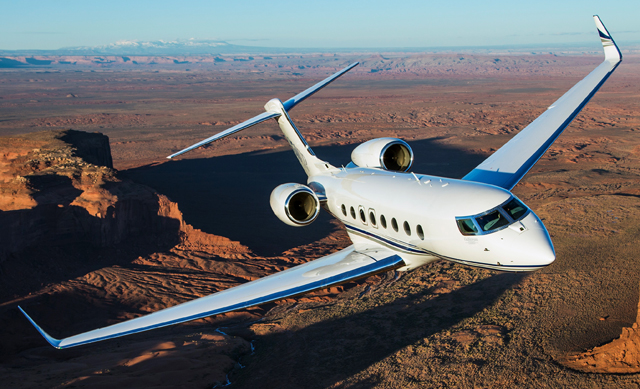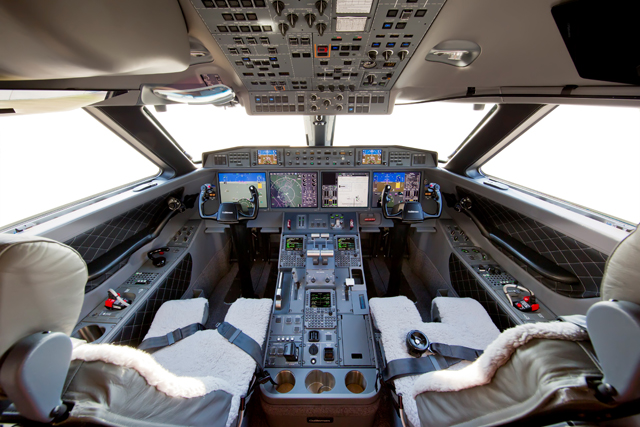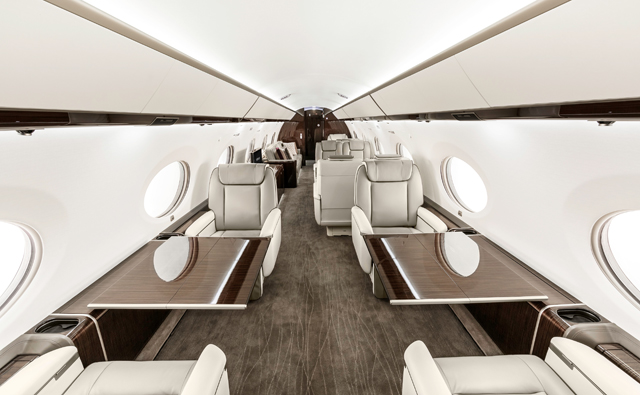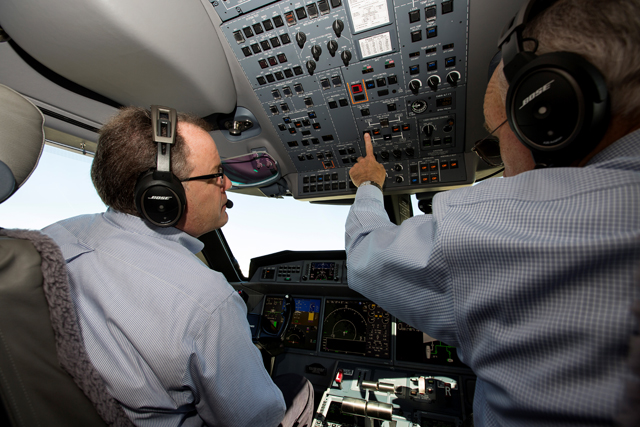It has been over 10 years since I flew a large-cabin Gulfstream, when I was awed by the G550’s ability to fly eight passengers in comfort over 6,750nm (12,500km). With the clean-sheet G650, Gulfstream has advanced the state of the art in several areas. Since it received US Federal Aviation Administration certification in September 2012, over 100 examples of the large-cabin ultra-long-range twinjet have been delivered. The G650ER is an enhanced-range version of the G650, offering sumptuous accommodation and a 500nm range increase. When Flight International was offered an opportunity to fly the G650ER, I was excited to see just how far Gulfstream had raised the bar over the last decade.

Gulfstream
New York to Hong Kong
With a range of 7,000nm at Mach 0.85, the G650 advanced the marker for business jets carrying eight passengers in its large cabin. Already the most capable large-cabin business jet, one important city pairing exceeded its grasp, however: New York to Hong Kong. Within the existing wing profile Gulfstream found space for 9% more fuel. The additional 1,810kg (4,000lb) of fuel is accommodated by changes to the existing fuel system, fuel monitoring system and flight management system (FMS) software. Gulfstream also increased maximum take-off weight by 1,810kg, increasing range and payload flexibility. With eight passengers, the G650ER’s 500nm range improvement makes New York-Hong Kong possible (Gulfstream reported a distance of just shy of 7,500nm with 85% Boeing winds and IFR reserves). On a shorter 7,000nm leg the G650ER can fly faster – shaving 30min off the sortie – or carry an additional 910kg of payload.
While the G650ER’s range improvement is certainly noteworthy, it would be foolish to let it totally eclipse the capabilities and comforts the G650 has brought to its operators. The G650’s fuselage has an ovoid cross-section that maximises usable interior volume while reducing wetted area and drag. Cabin height and width, compared to Gulfstream’s former standard-bearer the G550, are increased by 7.6cm (3in) to 195.6cm and by 135.6cm to 259cm respectively. The cabin has also been lengthened by about 1m, increasing volume to 60.54m3, a 28% increase.
Gulfstream offers a large number and variety of interior configurations to suit its customer’s varied needs. According to Lor Izzard, director of sales support and technical marketing, the G650 cabin has four living areas, each approximately 2.7m long. For ultra-long-haul operators, the forward area can be configured as a crew area with its own lavatory, ensuring privacy for passengers as well as a well-rested crew. Regardless of the configuration chosen, cabin ambient lighting is enhanced by 16 trademark Gulfstream oval windows. Each is 16% larger than those found on the G550 and they run the full length of the cabin.
Upfront enhancements
Unlike a chauffeured Rolls-Royce, the R-R-powered G650 does not coddle its passengers at the expense of the drivers. The G650 comes equipped with Gulfstream’s impressive PlaneView II flightdeck. Based on Honeywell’s Primus Epic avionics, the PlaneView II system features four large (14.2in) LCD displays and two standby multifunction controllers (SMFCs) with 5in displays. In addition to their control functions, the displays also act as standby instrument cluster/primary flight display (PFD). Other standout features are an LCD head-up display, enhanced vision system (EVS) and synthetic vision PFD (SV-PFD). The G650’s cockpit is paperless, with JeppView charts and an electronic checklist (ECL). Each G650 comes with three PlaneBook subscriptions, which presents the Quick Reference Handbook (QRH) and other flight-related publications on an iPad.
Impressive as the flightdeck is, the biggest change is most likely to go unnoticed by the passengers – and perhaps even the pilots. In a first for Gulfstream, the G650 has a fly-by-wire (FBW) flight control system. Gulfstream has retained a conventional yoke for its first FBW aircraft, as had Boeing when it fielded the 777. The G650’s quadruplex digital system has three flight control computers (two primary and one backup FCC) and controls all three axes. Each primary flight control surface has two hydraulic actuators, powered by the aircraft’s left and right hydraulic systems, as well as an electrical backup hydraulic actuator (EBHA). The EBHAs incorporate a self-contained hydraulic source and require only electrical power to operate. Dedicated batteries for the EBHAs and FCCs are installed. A ram air turbine (RAT) is fitted to charge the batteries in the event all engine and APU-driven generators fail.

Gulfstream
FBW scheme
Both the G650 and Boeing 777 have conventional yokes, while FBW Airbus and Embraer aircraft have sidesticks. Which manual interface is preferable – yoke or sidestick – is still a debated topic. The desire for a common type rating with the 777 is likely to have been the deciding factor in Boeing putting a yoke in the 787. Gulfstream’s selection of a yoke for the G650 may well have been to increase commonality with its other large-cabin offerings, the G550 and G450. Gulfstream will use active sidesticks in their G500/G600 aircraft, which should be an improvement over current passive sidesticks.
What type of controller the pilot manipulates is only part of the equation, because behind the curtain are the all-important flight control schemes. Each manufacturer has developed its own flight control laws (FCLs). Broadly speaking, roll control laws have settled into either a roll rate command system or proportional deflection of the roll control surfaces. For “yaw” control most schemes have the rudder pedals commanding sideslip angle (beta). Where there is a good amount of discussion is whether the roll and yaw axis should be coupled or uncoupled. In a conventional aircraft, sideslip usually generates a roll in the direction of the rudder pedal input, termed roll due to yaw. FBW control schemes can decouple these axes, rudder displacement commanding a pure wings-level sideslip.
Control schemes in the pitch axis are seemingly unique to each manufacturer. For the sake of brevity, pitch FCL descriptions below are for the up-and-away flight conditions. Airbus employs a C* scheme: pitch rate command at slower speed transitioning to G command at high speed. Boeing uses C* U: similar to Airbus’s but with the “U” representing apparent speed stability, which provides the kind of response to a speed change that a pilot would expect to see in a conventionally controlled aircraft. Embraer has elected to use a pitch rate command system throughout the speed range. One reason pure G command schemes have not found greater use is that they can be overly sensitive at slower airspeeds.
For the G650, Gulfstream has developed its own unique set of FCLs. The normal FBW flight controls have two modes: take-off and landing (TOL); and up and away. Extending either the landing gear or flaps puts it into the TOL mode. In the up and away mode, the G650 Gulfstream’s pitch control scheme is a G command with apparent speed stability. In TOL it is proportional control with a Qbar (dynamic pressure input) to normalise aircraft response. In roll the flight control laws are the same for both TOL and up and away modes. Based on proportional control with a Qbar modifier, the FCL is designed to provide a linear progression in roll rate for given yoke displacement, regardless of speed. Relative aileron and spoiler deflections are mixed to provide consistent roll rates. As with roll, yaw FCLs are the same for both TOL and up and away. Rudder pedal inputs command rudder deflection, which in essence commands yaw rate (beta dot). There is a Qbar-based gains schedule to provide uniform aircraft response over its speed range. The G650’s roll and yaw axes are coupled, rudder input causing a corresponding roll response.

Gulfstream
FBW protections
For most business/transport aircraft, the most demanding tasks occur in the take-off and landing phases of flight. While highly unlikely, an engine failure on take-off can be a life-defining moment. Both Airbus and Boeing have tailored their FCLs to mitigate risks and reduce pilot workload during an engine-loss event. A FBW Airbus will initially act like a conventionally controlled aircraft, allowing limited wing-drop on the dead engine side and limited yaw in that direction, allowing the pilots to see and feel the asymmetry, hopefully reacting by correcting it with rudder input. In Boeing’s 777 and 787, the thrust asymmetry compensation systems (TACS) render most engine-failure events feet-on-the-floor non-events. As detailed above, the G650’s FCLs in TOL are essentially digitised conventional controls, with yoke and pedal displacement commanding proportionate surface deflection. While the G650’s rudder does have low-to-moderate forces, Gulfstream has elected not to offer any enhanced features to mitigate risk during an engine failure. For landings, a stabilised ILS approach is about as easy as it gets. A sidestep or circling manoeuvre during an approach at night to minimums, however, can be an order of magnitude more difficult. While sidestep and circling manoeuvres were not evaluated during my preview flight, the proportional control nature of the G650’s FCLs in the TOL mode should ensure it handles as well as the G550, with the benefit of lower control forces.
Of course FBW flight controls offer the opportunity to provide other automatic envelope protections. Airbus has embraced this philosophy more than any other manufacturer. Boeing has also incorporated envelope protection features, but to a lesser degree than Airbus. With the G650 Gulfstream has adopted an even more minimalistic approach than Boeing. In pitch all three manufacturers provide both high- and low-speed protections. Airbus has again gone the furthest, limiting G as well as maximum pitch and dive angles. Both Airbus and Boeing provide some envelope protections in roll. In line with their envelope protection philosophy, Airbus limits the maximum angle of bank, while Boeing has a soft stop at 35˚ of roll, which can be overridden with more yoke force. Gulfstream has elected to forego restrictions in roll entirely.
Savannah sortie
The G650ER is the world’s longest-range business jet, and until recently was also the fastest. As I detailed in my Citation X+ flight test report (Flight International, 21-27 October 2014), the G650 had been pipped at the post by a mere one-hundredth of a Mach number. Other than having nearly identical top speeds, these are aircraft designed for markedly different missions. I was intrigued to see at first hand how Gulfstream’s class-leading ultra-long-range, large-cabin FBW speedster would handle. Tom Horne, Gulfstream’s senior test pilot, would guide me as we put the G650 through its paces. Horne and I had both been F-16 experimental test pilots at Edwards AFB prior to our civilian careers. Our shared background and prior G550 preview flight together instantly put me at ease.
During the preflight walk-around I could not help but notice how big the G650ER is with its 30.36m wingspan. In a first for the company, Gulfstream uses a bonding process to fabricate the fuselage, and with 80% fewer fasteners than the G550 it looked remarkably smooth. The large main entry door has two passive seals, using gravity for extension with electrical retraction. As mentioned above, the G605’s cabin is large – the largest ever offered by Gulfstream. Our preview aircraft, N650ER, was a production-representative demonstrator. The cabin was configured with a forward crew area, the three other plush living areas being dedicated to the passengers.
Entry into the PlaneView II flightdeck was facilitated by the smaller centre pedestal, compared to the G550. Once seated, I adjusted my seating position by reference to the eye alignment balls on the centre windshield pillar. Next, I lowered the head up display (HUD) to ensure I could easily read it without moving my head. The conventional yoke was similar in design to that on the G550, but not as wide. Horne said the FBW architecture gave lower roll control forces, allowing for narrower horns. The large, silver thrust levers were bracketed by two of the MCDUs and fell readily to hand. Each pilot’s F-16-esque cursor control device (CCD) was mounted on the outboard sidewall. Overall, the flightdeck’s layout was exceptionally clean and well thought-out.
Prior to engine start, Horne guided me through initialisation of the flight management system. I found the PlaneView II’s interface to be quite intuitive, with the CCD allowing for easy navigation through the various displays and pull-down menus. Horne ran the pre-start flows, checking each item off in the electronic checklist. Both engines were started using bleed air from the APU. Post-start checks were brief, and once cleared by the ground crew I released the parking brake by lowering its pedestal-mounted large, silver hand lever. Residual thrust from the R-R engines was enough to start the G650 rolling.
During the taxi to runway 10, I found the FBW nose-wheel steering and brakes allowed me to easily track taxiway centrelines and control speed. The G650 has three external-view cameras, whose feeds can be displayed on an MFD. I found the belly-mounted ones allowed me to see if I was dead on centreline. On especially narrow taxiway junctions it also lets you monitor where the main gear are tracking, so you avoid dragging a main mount in the weeds. In the big picture, having ownership position presented on the MFD’s airfield diagram allowed me to easily keep track of our position, and the Honeywell runway awareness and advisory system (RAAS) greatly reduced the chances of my wandering onto an active runway.
As we taxied onto runway 10, I checked that the flaps were set to T/O APP (20˚). Take-off reference speeds for the 30,930kg aircraft (6,300kg fuel) were 110, 111 and 120kt (220km/h) indicated airspeed for V1, VR and V2, respectively. Once cleared for take-off, I advanced the thrust levers. The auto throttles (ATs) engaged and set an engine pressure ratio of 1.59, which briskly accelerated the G650ER down the runway. Pitch control forces were light at VR and I was easily able to capture the initial climb attitude of 10˚. Pitch force changes for gear and flap retraction and during acceleration to the initial climb speed of 200kt were small and easily trimmed off. Out of the airport traffic area a climb speed of 250kt was held as we received vectors to our working area over the Atlantic. Passing 10,000ft I lowered the nose to capture 320kt, which was held until M0.82 was captured. From brake release, time to level off at FL490 was approximately 29min and required 1,090kg of gas. At maximum take-off weight the G650ER can climb directly to 41,000ft. Our test-day fuel and crew loading would have allowed us to climb directly to 51,000ft.

Gulfstream
Beating its brethren
Once level at 49,000ft, the aircraft accelerated at climb power (1.74 EPR) until it reached M0.85, long-range cruise speed. A total fuel flow of 2,300lb/h held an indicated airspeed of 211kt, and at a static air temperature of -66˚C (-87˚F) gave a true airspeed of 478kt. Next, I bumped the power up and set a total fuel flow of 2880lb/h. After a slow acceleration the aircraft settled at M0.90, high-speed cruise. Resultant true airspeed was 504kt. These test day results lend credence to the G650ER’s published (and demonstrated) range and speed capabilities. They are even more remarkable when compared to the G550. At first impression both aircraft should have similar performance. The ER’s wing loading at MTOW is 392kg/m2, nearly identical to the G550’s. Fuel fraction at MTOW is 46.52%, only slightly higher than the G550’s 45.38%. Yet the G650ER has nearly 10% greater range at its M0.85 LRC speed than does the G550 at its M0.80 LRC speed. With both aircraft holding M0.85, the G650ER’s advantage is 1,500nm, a 25% increase. The G650ER’s new BR725 engines are 3-4% more efficient than the G550’s BR710’s, which is not enough to explain the difference. Quite simply, the G650ER is a more aerodynamic aircraft. Its advanced supercritical wing is more swept than the G550’s, with more refined winglets that further reduce drag. These aerodynamic improvements explain why one of two nearly identical aircraft, from a parametric standpoint, has much better cruise performance.
Not only does the 650ER go farther and faster than the G550, but also its passengers are treated to an even nicer cabin environment. As mentioned earlier, the G650ER’s cabin is Gulfstream’s tallest, widest and longest. Level at 49,000ft I left the flightdeck to sample the cabin environment. Gulfstream’s parent company General Dynamics also has an electric boat division, and while quietness is important for a business jet, it is essential for a submarine. Gulfstream’s Izzard would not quote specifics, but my subjective evaluation of the G650’s ambient noise level was that it was one of the quietest I had experienced. Like a quieter cabin, a lower cabin altitude is also shown to be less fatiguing. The G650 has a 10.69∆p pressurisation system, and observed cabin altitude was just 4,620ft. At 51,000ft, published cabin altitude is only 4,850ft. As I returned to the flightdeck I reflected that the G650’s low cabin altitude and larger and quieter cabin shows good things do come in threes.
High- and low-speed protections
While still at altitude at M0.90, I did a series of 45˚ and 60˚ angle of bank (AoB) rolls. No buffet was felt at 45˚, but rolling to and capturing 60˚ AoB induced some airframe buffet. Yoke forces were, by design, linear and only 15kg of pull was required to hold a 2g (60˚) turn. I found the G650’s roll response to be crisp, allowing me to easily capture desired AoBs. Impressed with the G650’s high-altitude handling qualities, I next initiated a high-speed, idle-power descent, reflective of that needed in the event of a cabin depressurisation. Once established at M0.90, I extended the speed brakes. Their extension caused a slight pitch-up, requiring about 2kg of yoke pressure to counter. The descent rate stabilized at 9,900ft/min, a healthy rate that would enable the G650 to get to lower altitudes quickly. I next increased forward yoke pressure, accelerating to M0.925 and into the red band on the PFD’s airspeed tape (MMO). A “HIGH SPEED PROTECTION ACTIVE” message from the engine-indication and crew-alerting system (EICAS) alerted me that the FBW protections had kicked in. Additional forward yoke pressure had no effect: the G650 could not be over-sped.
Approaching 15,000ft, I retracted the speed brakes and slowed the G650 for two approach-to-stall manoeuvres. Horne said these would demonstrate the low-speed protection offered by the FBW control system. At idle power in a clean configuration the aircraft slowed at about 1kt/s. The stick shaker went off at an indicated airspeed of 127kt, a normalised AoA of 0.93. Full aft yoke pressure slowed the aircraft slightly and AoA increased to and stabilised at 0.94 AoA. The aircraft settled into a rock-steady wings-level descent. At this elevated AoA the aircraft was responsive to small control inputs in all three axes. Recovery to normal flight was accomplished by relaxing yoke back pressure and advancing the thrust to mid range. The next approach to stall was in a landing configuration, gear down and flaps down (39˚). Slowing again at about 1kt/s, the shaker activated at 98kt. Full aft yoke again caused the G650 to enter a stable wings-level 0.94 AoA descent. Advancing the power and lowering the nose recovered the G650 to normal flight conditions. The gear and flaps were retracted as we accelerated and turned towards home.
EVS snapshot
Our recovery to Savannah was via vectors to an ILS approach, where light winds allowed us to use runway 01. I hand-flew the approach, following the flight director’s guidance cues in the HUD. While we were in clear daylight conditions, I turned on the EVS system, which presented its infrared imagery in the HUD. EVS imagery precisely overlaid actual terrain features. The EVS’s IR window is mounted on the top of the G650’s radome, and I could discern little parallax error as we descended to the runway. At 350ft above the runway, the runway brackets closed in to accurately mark the runway’s edges. At 100ft above the runway I advanced the power to TO (1.60 EPR) and abandoned the approach. With the gear retracted, and flaps at T/O APP, Horne rapidly pulled the right thrust lever to IDLE, to simulate an engine loss at V2. As the nose yawed right I put in a moderate amount of left rudder. Only about 12kg of force was needed to arrest the yawing, and keep us tracking down the extended centreline. While I favour systems like the 777’s TACS, the G650’s low pedal forces and precise yaw control made the simulated V2 cut manoeuvre easy to manage.
Once reaching pattern altitude Horne gave the right engine back to fly our last approach, a GPS guided area navigation approach to runway 10. The approach, flown with GPS guidance in both lateral and vertical planes, had a LPV (localiser performance with vertical guidance) decision altitude of 230ft MSL, 200ft above the TDZ (touch-down zone). With credit for the EVS, approach minimums were only 100ft above TDZ, equal to a typical ILS CAT II. I engaged the autopilot and autothrust for the approach. With the target speed of 139kt being held by the AT, the G650 smoothly tracked both the lateral and vertical paths. Passing about 200ft AGL I disconnected the AP and hand-flew the remainder of the approach. Passing 50ft AGL I clicked off the ATs and slowly retarded the thrust levers to IDLE. On touchdown I lowered the nose wheels to the runway and selected reverse thrust. Speed brakes and ground roll spoilers automatically deployed and moderate toe braking quickly slowed the G650ER for runway turn-off. The short taxi to Gulfstream’s ramp was uneventful, with shutdown and post shutdown procedures easily accomplished.
Great design goes unnoticed
The 2h preview flight in the G650ER allowed me to gain valuable insights into the world’s premier large-cabin, ultra-long-range business jet. While only a decade separates them, the G650 and its longer range ER variant are heads and shoulders above their G550 predecessor. The aircraft’s enhanced capabilities are primarily the result of a new highly refined supercritical wing. Upfront, the PlaneView II flightdeck is even more capable, sporting a standard EVS that will allow arrival at many smaller airports in the most demanding weather conditions. What may go unnoticed by the passengers and even some pilots is the FBW control system. Pitch, roll and yaw responses are largely normalised across the flight envelope, providing precise handling qualities throughout. The FBW control scheme provides envelope protection at high and low speeds, without further restrictions. Overall I found the G650ER was a joy to fly, with control forces lower than those in the G550. No one will buy a G650/G650ER because it has a FBW flight control system. This pilot, however, found the G650ER handled like an aircraft should, a great reflection of the utility and refinement Gulfstream has built into it.
Source: FlightGlobal.com



















